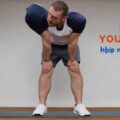Introduction to Deadlift Variations
The deadlift is a fundamental exercise that targets multiple muscle groups and is crucial for building strength and muscle mass. While the traditional deadlift is highly effective, incorporating different variations can enhance your workout routine, prevent plateauing, and reduce the risk of injury. In this article, we will explore some essential deadlift variations that you should consider integrating into your fitness regimen.
Conventional Deadlift
The conventional deadlift is the most common form of deadlifting. It primarily targets the posterior chain, including the glutes, hamstrings, and lower back. To perform a conventional deadlift:
- Stand with your feet hip-width apart.
- Bend at the hips and knees to grip the barbell with an overhand grip.
- Keep your back straight and chest up as you lift the barbell by extending your hips and knees.
- Lower the barbell back to the ground in a controlled manner.
Sumo Deadlift
The sumo deadlift is a variation that involves a wider stance and targets the inner thighs, glutes, and quads. It is easier on the lower back and can be a great option for individuals with mobility issues. To perform a sumo deadlift:
- Stand with your feet wider than shoulder-width apart and toes pointed slightly outward.
- Grip the barbell with your hands inside your legs.
- Keep your chest up and back straight as you lift the barbell by extending your hips and knees.
- Lower the barbell back to the ground in a controlled manner.
Romanian Deadlift
The Romanian deadlift (RDL) focuses more on the hamstrings and glutes while placing less stress on the lower back. It is performed with a slightly different technique:
- Stand with your feet hip-width apart and hold the barbell with an overhand grip.
- Keep your knees slightly bent and hinge at the hips to lower the barbell down the front of your legs.
- Maintain a straight back and lower the barbell until you feel a stretch in your hamstrings.
- Return to the starting position by extending your hips.
Trap Bar Deadlift
The trap bar deadlift, or hex bar deadlift, is performed using a trap bar, which reduces strain on the lower back and places more emphasis on the quads. This variation is ideal for beginners and those with lower back issues. To perform a trap bar deadlift:
- Stand inside the trap bar with your feet hip-width apart.
- Grip the handles on either side of the bar.
- Keep your chest up and back straight as you lift the bar by extending your hips and knees.
- Lower the bar back to the ground in a controlled manner.
Deficit Deadlift
The deficit deadlift is performed by standing on a raised platform, increasing the range of motion and targeting the muscles more intensely. This variation is beneficial for improving strength off the floor. To perform a deficit deadlift:
- Stand on a platform or weight plate with your feet hip-width apart.
- Grip the barbell with an overhand grip.
- Keep your chest up and back straight as you lift the barbell by extending your hips and knees.
- Lower the barbell back to the ground in a controlled manner.
FAQ
What muscles do deadlifts target?
Deadlifts primarily target the posterior chain, including the glutes, hamstrings, and lower back. They also engage the core, quads, and upper back muscles.
Are deadlifts safe for beginners?
Yes, deadlifts can be safe for beginners if performed with proper form and technique. It’s advisable to start with lighter weights and gradually increase the load as you become more comfortable with the movement.
How often should I include deadlifts in my workout routine?
It is recommended to include deadlifts in your workout routine 1-2 times per week, allowing sufficient recovery time between sessions.
Can deadlifts help with weight loss?
Deadlifts can contribute to weight loss by increasing muscle mass, which in turn boosts metabolism. They also burn a significant amount of calories due to the engagement of multiple muscle groups.
What is the difference between a conventional and a sumo deadlift?
The primary difference between a conventional and a sumo deadlift is the stance. In a conventional deadlift, the feet are hip-width apart, while in a sumo deadlift, the feet are wider than shoulder-width apart. The sumo deadlift also places more emphasis on the inner thighs and quads.









